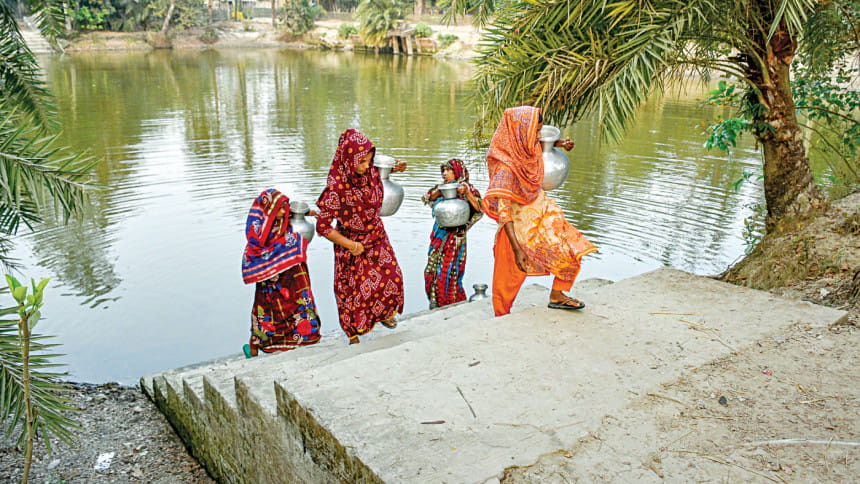Coastal areas of Khulna: Struggle for safe drinking water getting tougher


Waking up before dawn, Dipali Mondal takes a three-km walk every day to collect drinking water from a pond for her five-member family in Channirchak village of Khulna's Dakop upazila.
She needs to walk through a bumpy road to the pond.
"I have to cross a big canal on the way to fetch pond water. On a sunny day, I cannot walk much at a stretch. To have a break, I sit down somewhere. Sometimes, my 10-year-old son comes with me carrying a plastic barrel.
"I carry at least two pitchers of water for my family members every day. If I am not well, my husband carries water," she said.
Like Dipali, hundreds of women and men from eight villages under Kamarkhola union come to the pond to collect water as they cannot use water in their villages due to salinity intrusion and arsenic contamination. Many of them carry big barrels and hire locally made vehicles known as Nasiman to fetch water from the pond.
"Over 75 percent people from some 5,000 families in my union don't have access to pure drinking water in their areas," said Panchanan Kumar Mondal, chairman of the union.
According to the Department of Public Health Engineering (DPHE) in Dakop, there are some 49 government ponds in the upazila and many of those have dried up due to lack of re-excavation.
The DPHE could re-excavate only nine of those ponds as it had disputes with locals over the rest. As a result, most of the ponds have dried up.
There are only 27 deep tube-wells for around 153,000 people in about 130 villages in Dakop. Water from only two of those is drinkable.
There are over 1,300 shallow tube-wells, but water from most of those is not drinkable due to salinity and arsenic contamination, according to DPHE.
Apart from ponds, Panchanan said, the families are mainly dependent on rain water harvesting, pond-sand filter, reverse osmosis and deep tube-wells for drinking water. But all these technologies are expensive and not affordable to low-income families, he said.
Abdullh Al Mahmood, sub-assistant engineer of DPHE in Dakop, said the department provided 8,000 water tanks to low-income people for rainwater harvesting.
"As the salinity in the water of tube-wells is increasing, we have to focus on surface water," he added.
The situation in Koyra, another coastal upazila of Khulna, is not much different.
There are around 7,000 tube-wells in Koyra and water from 3,784 of them is not drinkable.
There are 13 government ponds in the upazila, but most of them are in poor state, said DPHE officials.
Baharuddin Mridha, superintendent engineer of DPHE (Khulna Circle), said people in many upazilas of Khulna and Satkhira are facing an acute drinking water crisis due to salinity and arsenic contamination, with salinity affecting almost all water sources there.
Apart from Dacope and Koyra, Batiaghata, Dumuria, and Paikgacha upazilas in Khulna and Shymnagar, Ashshuni, Kaliganj, Tala and Debhata upazilas in Satkhira are the worst affected upazilas, he added.
Fisheries department officials said use of salt water in shrimp cultivation, currently being done on 1.45 lakh hectares in Khulna, Satkhira and Bagerhat, also affects freshwater reservoirs.
Dilip Kumar Datta, former professor of environmental science at Khulna University, said salinity is increasing in rivers, ponds and other water bodies.
He said the government should declare the southwestern region a special zone and act accordingly because of the water crisis.
He observed that rainwater could be a solution to the water crisis. "Open ponds and rain water can mitigate the basic water crisis in coastal areas."

 For all latest news, follow The Daily Star's Google News channel.
For all latest news, follow The Daily Star's Google News channel. 








Comments